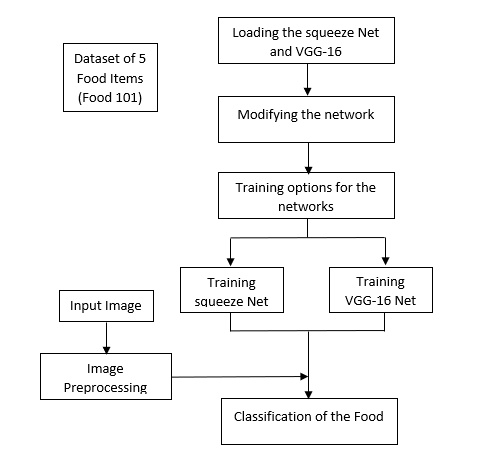Automated Food image Classification using Deep Learning approach
Objective
In this paper, automated methods of food classification using deep learning approaches are presented. SqueezeNet and VGG-16 Convolutional Neural Networks are used for food image classification.
Abstract
Because of its growing importance in the health and medical fields, food image categorization is a new research subject. Automated food recognition techniques will undoubtedly aid in the development of diet monitoring systems, calorie estimation, and other similar applications in the future. Automated food classification methods based on deep learning algorithms are discussed in this research. For food image classification, SqueezeNet and VGG-16 Convolutional Neural Networks are utilized. It was shown that applying data augmentation and fine-tuning the hyper parameters improved the performance of these networks, making them appropriate for practical applications in the health and medical domains. Because SqueezeNet is a lightweight network, it is easy to set up and maintain. SqueezeNet can attain a high level of accuracy even with fewer parameters. Extraction of complex features from food photographs improves the accuracy of food image classification. The suggested VGG-16 network improves the performance of automatic food image classification. The planned VGG-16 has improved significantly as a result of increased network depth.
Keywords: Food Classification, Image processing, Squeeze Net, VGG-16 Network, Transfer learning.
NOTE: Without the concern of our team, please don't submit to the college. This Abstract varies based on student requirements.
Block Diagram

Specifications
Software: Matlab 2020a or above
Hardware:
Operating Systems:
- Windows 10
- Windows 7 Service Pack 1
- Windows Server 2019
- Windows Server 2016
Processors:
Minimum: Any Intel or AMD x86-64 processor
Recommended: Any Intel or AMD x86-64 processor with four logical cores and AVX2 instruction set support
Disk:
Minimum: 2.9 GB of HDD space for MATLAB only, 5-8 GB for a typical installation
Recommended: An SSD is recommended A full installation of all MathWorks products may take up to 29 GB of disk space
RAM:
Minimum: 4 GB
Recommended: 8 GB
Learning Outcomes
- Introduction to Matlab
- How to start with MATLAB
- About Matlab language
- Matlab coding skills
- About tools & libraries
- Application Program Interface in Matlab
- About Matlab desktop
- How to use Matlab editor to create M-Files
- Features of Matlab
- Basics on Matlab
- What is an Image/pixel?
- About image formats
- Introduction to Image Processing
- How digital image is formed
- Importing the image via image acquisition tools
- Analyzing and manipulation of image.
- Phases of image processing:
- Acquisition
- Image enhancement
- Image restoration
- Color image processing
- Image compression
- Morphological processing
- Segmentation etc.,
- How to extend our work to another real time applications
- Project development Skills
- Problem analyzing skills
- Problem solving skills
- Creativity and imaginary skills
- Programming skills
- Deployment
- Testing skills
- Debugging skills
- Project presentation skills
- Thesis writing skills


 Paper Publishing
Paper Publishing
